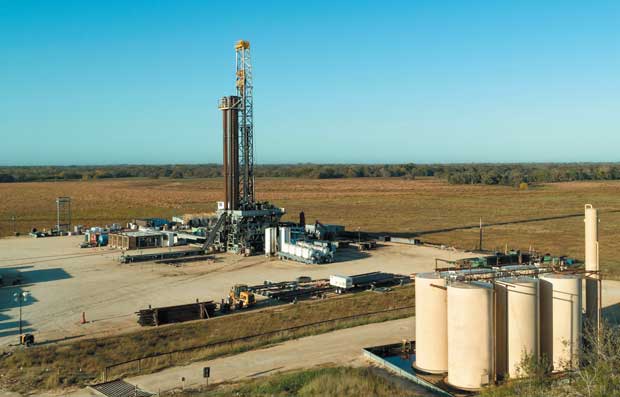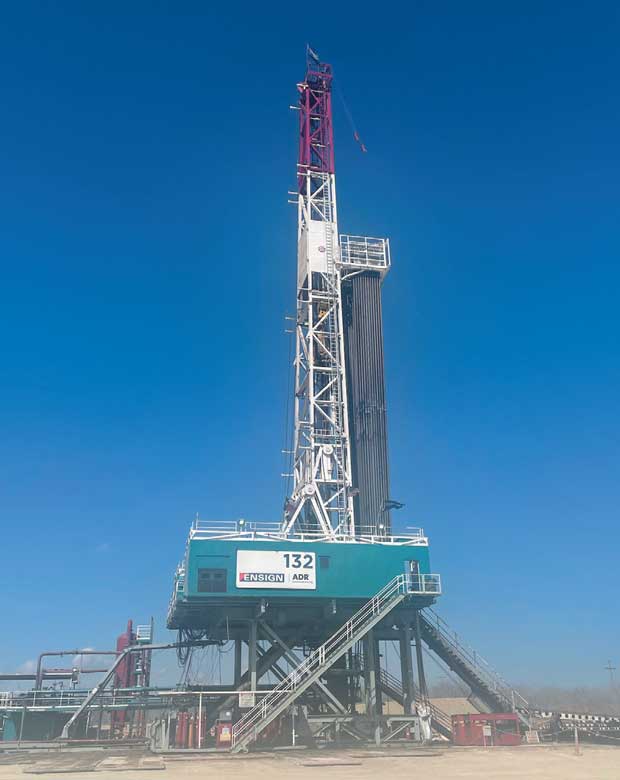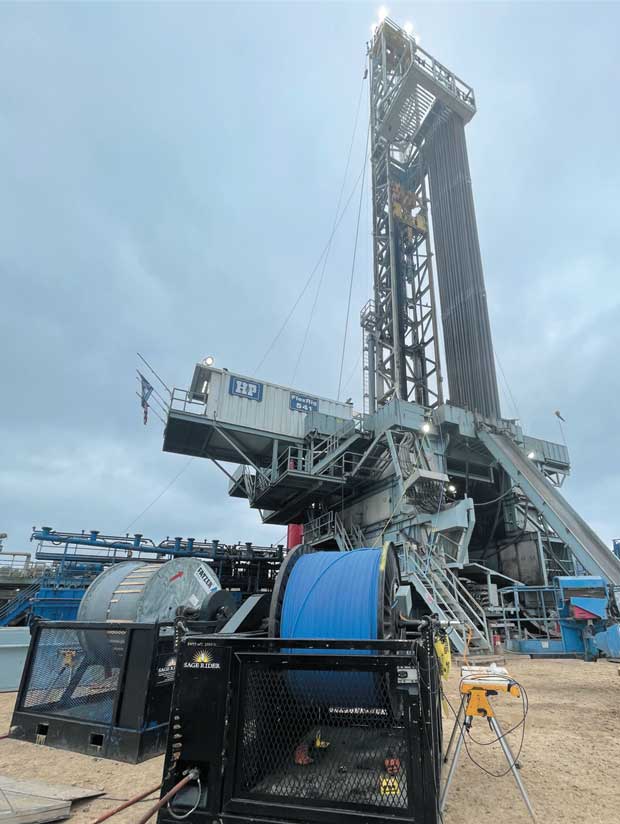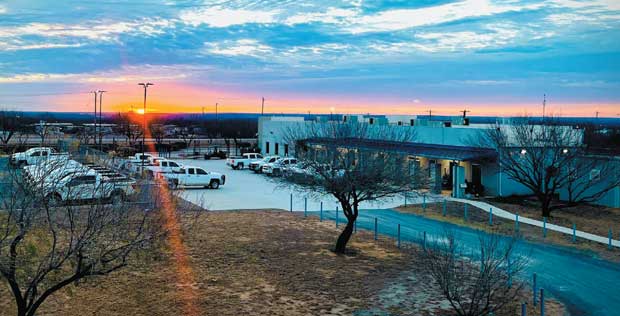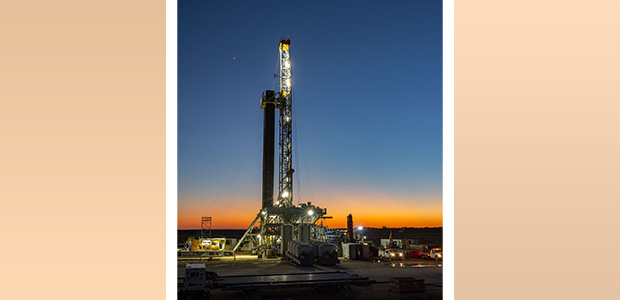
New Drills, New-Age Refracs On Operators’ Rosters In Eagle Ford, Austin Chalk
By Danny Boyd, Special Correspondent
Spanning 26 South Texas counties, the 400-mile-long Eagle Ford Shale is regaining momentum as numbers rebound for active rigs, drilling permits and production. The play’s depth-delineated geologic windows of oil, wet gas and dry gas, give Eagle Ford operators abundant opportunities, and the re-emergence of interest in the Austin Chalk adds another layer of versatility.
At various times since the play was commercialized, Eagle Ford activity has been alternately dominated by the ebb and flow of oil, NGL and gas prices. But the ideal scenario is playing out today, with strong prices for both liquids and gas. Operators say the time is right for increased drilling and the stage is set for refracturing work to arrest declining wells, too.
In March, the basin produced an average of 1.12 million barrels of oil and 6.3 billion cubic feet of natural gas a day, reinforcing its prominence among U.S. resource plays. The vast majority of that output was bound for growing Gulf Coast refinery and petrochemical plants, as well as the crude oil and liquified natural gas export facilities feeding hungry markets in Europe and Asia.
Eagle Ford Strategies
Eagle Ford players are deploying the latest technologies to enhance drilling and completion operations and look to additional basin consolidation. The number of refracs of first-generation wells is expected to increase, with several players already pursuing restimulation projects.
In late March, the Eagle Ford rig count stood at 56, almost double the count from a year earlier. Permitting across the region should continue to pick up at a steady clip, says Matt Mayer, product manager for well data at TGS. Overall permitting in South Texas, including the Austin Chalk, is on the rise with oil well development continuing to outpace gas drilling.
“We are looking at a 17% increase from 2021 prorated so far this year for permitting in the Eagle Ford and the Austin Chalk, following the same trend line that occurred during 2021,” Mayer says.
While some operators continue to exploit the oil and gas benches in the upper and lower Eagle Ford, others are focusing on the Austin Chalk, the most profitable among four Texas plays on a net present value basis, according to a 2020 TGS study, Mayer points out. Still, overall drilling permits for the Eagle Ford Shale continue to outpace the Austin Chalk, he adds.
New Name, Long Legacy
With a new name reflecting a Texas heritage and oil-producing legacy, Ranger Oil Corp. continues to eye growth opportunities, deploy proven drilling and completion systems and upgrade operations to boost returns from an oil-weighted, 140,900-acre Eagle Ford position.
“We are proud of being an oil company and providing the affordable, reliable energy that our country needs and demands,” says President and Chief Executive Officer Darrin Henke.
In October, the company rebranded to Ranger Oil from Penn Virginia when it closed on its acquisition of established Eagle Ford player Lonestar Resources, which followed a 2021 bolt-on from Rock Creek Resources. The Lonestar deal added 50% more production, approximately 60% more acreage and approximately $25 million in annual synergies, Henke points out.
As part of its continuous improvement processes, Ranger Oil increased its average footage drilled per day by 19% and number of stages stimulated per day by 20% in 2021. This year, it is continuing to optimize well results by transitioning to 6-inch instead of 51⁄2-inch casing to achieve higher frac pump rates.
Ranger wants to continue to expand in a region ripe for additional consolidation, given a disproportionately high number of operators to overall production, he says.
With a 20-year drilling inventory at a current pace of approximately 50 wells a year, the company has 750 locations in the lower Eagle Ford Shale. Included also are 200 other locations prospective for both the Upper Eagle Ford and Austin Chalk, two benches the company is not yet drilling although other operators are proving up both in Texas’ Gonzales, Lavaca and De Witt counties, Henke explains.
In the relatively low-risk Eagle Ford, Ranger is extending lateral lengths as technical and land teams continue to expand long-lateral inventory by identifying and adding smaller, adjacent tracts to existing leases, he says.
Laterals being drilled in the upcoming next two years are expected to average close to 10,900 feet–30% longer than in 2021–with efficiencies helping offset some inflationary pressure, Henke says. The company is experimenting and applying best practices on downhole assemblies to operate above 320 degrees Fahrenheit to bore the entire well without a trip, he explains.
The company’s drilling efficiencies led to several internal “bests” in 2021, and average feet drilled per day rose 19% last year and stages stimulated in a day by 20%, Henke goes on.
Continuous Improvement
“What it really all boils down to is having a continuous improvement mindset,” Henke comments.
After tests on several wells last year, by September Ranger aims to case all Lower Eagle Ford wells with 6-inch casing instead of 51⁄2-inch pipe, he reveals. The larger pipe means quicker execution and lower costs with fewer frac stages, wireline runs and plugs, he notes. Pumping rates can be boosted from 90 to 120 barrels/minute.
With 200-220-foot stage lengths, wells will be stimulated with 2,200 pounds of sand and 2,500 gallons of slickwater per foot, although adjustments will be made by target, Henke says. In an experiment in the late first quarter of 2022, Ranger’s completions team increased proppant loading by 25% in a well in efforts to further refine the design, he adds.
Completion results have been strong across Ranger’s acreage, Henke points out. The Bloodstone C3H and D4H wells in Lavaca County include average 30-day initial production of 1,340 barrels of oil a day and average 90-day IPs of 900 bbl/d.
To drive down field costs, Henke reports that Ranger continues to upgrade compression and install jet pumps and annular gas lift as part of a program of production management to “bend the curve” and decrease natural decline rate.
The accomplishments buttress financial performance that in 2021 put Ranger atop a list of publicly traded U.S. independents in EBITDAX margin, due to its high oil cut, low operating cost and premium product pricing given its location on the Texas Gulf Coast, Henke says. The company stated in its latest earnings release that at current oil prices it expected more than $250 million of free cash flow in 2022, which is helping Ranger self-fund its development program while simultaneously continuing to pay down debt.
While the company’s focus remains on drilling new wells, Henke adds that the Ranger team continues to assess candidates for refracturing, although none are currently planned.
Focusing On Two Targets
Relying on seismic and measurement-while-drilling data, Crimson Energy Partners IV is optimizing landings in two oil-saturated layers of the Lower Eagle Ford while keeping an eye out for growth prospects in the basin’s southwestern edge, says President Frank F. Starr II.
Basin veterans from their days at Austin Chalk horizontal drilling pioneer Union Pacific Resources, Starr and partner Tripp Rivers launched Fort Worth-based Crimson IV in 2016 with a 5,000-acre position in Dimmitt and LaSalle counties along the Rio Grande. A subsequent bolt-on acquisition from Stonegate Production expanded that to almost 28,000 acres.
Crimson Energy Partners IV is focusing its planned 15-well 2022 drilling program on two oil-saturated layers of the Lower Eagle Ford in its 28,000-acre position in Texas’ Dimmitt and LaSalle counties.
Production from 150 wells, including 34 new wells drilled since acquisition, is 80% oil. This year, 15 new wells are planned, Starr says.
“We have identified two targets, what we call the ‘Lower, Lower Eagle Ford’ and about 60 feet above that the ‘Upper Lower Eagle Ford,’” he explains.
The lowest bench is the primary target with 35 feet of pay 7,600 feet down. A naturally occurring gamma hot streak, with counts of 135-140, coupled with seismic logs, help target landings for laterals up to 10,000 feet in length, Starr says.
The company continues to utilize bigger fracs of 2,800 pounds of proppant per foot compared with first-generation stimulations that pumped only 600-1,000 pounds/foot. Wider stage spacings of 500 feet have been reduced to about 200 feet, Starr says. Early completions included Tepumping the first 25% of the lateral with 100-mesh sand and finishing it with 30/50 or 40/70-mesh.
“We have completely changed that design to where we are now pumping about 75% with 100-mesh and tailing in with 25% of 30/50-mesh,” Starr explains.
Consistent choke management over the first 60 days around bubble-point pressures helps prevent gas from breaking out of solution too early, he says. Within about 45 days, oil production from the bench typically averages 500 bbl/d. Over the timeframe, gas output can climb to 500 Mcf/d, but as management hits the bubble point, output climbs to 1 MMcf-1.5 MMcf a day, Starr says.
Flowback water ranges from 500 to 600 bbl/d, but declines to on the order of 100 bbl/d within a year and eventually to 15-20 bbl/d.
The current focus is on new drilling for higher returns, Starr says, but Crimson has done one refrac and identified 50-60 candidate wells for rework down the road.
The company also continues to look for the right opportunities to add acreage, Starr says. “We can pick up existing production, but in general we look at bolting on acreage to give us a more contiguous position, which makes it easier operationally,” he concludes.
Joint Venture Successes
With a combination of step-outs, infill drilling and refracs, Devon Energy Corp. and joint venture partner BPX Operating are busy using the latest downhole technologies to develop 86,000 Eagle Ford acres in the volatile oil window in DeWitt County, says Aaron Ketter, Devon’s vice president of the Mid-Continent and South Texas.
Production from about 930 wells includes 50,000 barrels of oil and 240 Mcf of gas a day, he relates. This year, 37 new wells are planned, along with 50 completions.
The venture is performing step-outs in areas viewed in the early days of the play as less economical because of thinner pay and higher gas-to-oil ratios, but modern frac designs of 2,700 pounds of proppant and 50 barrels of fluid per foot, along with the latest completion technologies, are producing solid results, Ketter reports.
The partners are deploying a variety of diagnostics, including Devon’s patented, proprietary sealed wellbore pressure monitoring technology that measures frac propagation and provides insight into downhole fracture geometry, he explains. Downhole pressure gauges measure drawdown trends in various landings and spacing considerations.
In addition to step-out and infill development on 86,000 Eagle Ford acres in DeWitt County, Devon Energy Corp. and joint venture partner, BPX Operating are conducting a two-well refrac project as part of a U.S. Department of Energy hydraulic fracturing test site series.
Lateral lengths across the position vary widely from 5,000 to 10,000 feet because of configurations established in the past, Ketter adds.
Early development performed at less optimized spacing in the same plane resulted in wells being unable to fully exploit the reservoir, he reviews. Now, the partners are drilling 12 staggered infills on drilling spacing units (DSUs) with as many as 12 existing wells, Ketter says.
“With a mix of landing intervals in the Lower and Upper Eagle Ford benches, the diagnostics have shown that keeping wells off plane from one another is important to optimize DSUs for density and ultimate recovery,” he explains.
Production interference testing has become increasingly critical to determining how two wells communicate early on and in late life, Ketter says, but the Eagle Ford is unique because that conductivity often significantly diminishes within the first six months under current spacing configurations, allowing for dense development.
The development program has included 27 liner refracs on first-generation wells. Currently, the venture is participating with the Gas Technology Institute in a U.S. Department of Energy-funded Hydraulic Fracturing Test Site, with work ongoing on the third phase in a two-well refrac project, Ketter reports.
The joint venture drilled a horizontal monitoring well and captured 420 feet of horizontal whole core to examine fracture propagation and the location of proppant from an original parent well, he explains. The team then refractured two wells and infilled with three new wells, he says. To get a holistic look at refrac effectiveness, the project has utilized permanent fiber optic, disposable fiber optic, sealed wellbore pressure monitoring, timelapse geochemistry, pressure gauges and tracers.
“The quick takeaway is that we are happy with the performance and technical results,” Ketter says. “This has been a great project for us and we have a significant inventory of refracs that we look forward to pursuing in the future.”
Rationale For Refracs
Rates of return and net present values for refracs are now highly competitive with new well drilling, says Robert Barba, president of Integrated Energy Services, pointing to its recent study that evaluates the post-refrac production declines for 58 Eagle Ford refracs. The P50 IRR using an initial year WTI price of $75.70 (price on Oct. 1, 2021) was 85% and the NPV was $4.6 million.
“Virtually all the objections that people have had against refracs in the past are gone,” Barba says. “If the refrac candidate has adequate volumes of stranded hydrocarbons between large cluster spacings, or if an infill child well is adjacent to the refrac candidate, refracs are an attractive option to maximize asset value.”
These competitive economics can be achieved for 60%-70% of the cost of a new drill with a lot fewer moving parts, he goes on. Isolation of the initial depleted clusters is derisked significantly with mechanical liners or cemented casing over diverter-only treatments. “They are no longer a ‘pump-and-pray’ exercise that often didn’t answer the prayers,” Barba remarks.
Prior to 2015, almost 9,000 wells in the Eagle Ford were completed with cluster spacings that were three or more times wider than current spacing, he explains, leaving significant volumes of stranded hydrocarbons. With a frac draining only 7.5 feet of lateral around each cluster, as much as 85% of the oil was left in place with 50-foot cluster spacings, Barba insists.
In one area of the study, five refracs had combined recovery factors (cumulative plus EUR) averaging 13.7%, while six offset new-drill completions with nearly identical stimulation treatments and spacings averaged 8.8%. Refracs in wells with original effective cluster spacings greater than 50 feet can have three-four times the original recovery factors because of the large volumes of hydrocarbons initially left behind the pipe, he reports. Refracs also protect infill child wells from asymmetric fracs draining only 60% of reserves by refracturing the primary well on the pad in the zipper sequence when the infills are ready to be refractured.
Existing perforations can be isolated with diverters, cemented smaller-ID casing or expandable liners. While cemented liners are a major improvement over diverter pump-and-pray treatments, expandables should be more efficient than cemented liners with more space available inside the liner to allow for higher pump rates.
“This increased rate can facilitate one to two additional clusters per stage and fewer frac stages overall,” Barba remarks. “They can also accommodate the larger perforating guns that can deliver the recommended 0.45-0.50 inch single topside perf per cluster architecture and should have less perf erosion from the essentially metal-on-metal cementless contact between the inner and outer strings.”
The geological risk is minimal compared with a new well, Barba continues, and condensate yield uncertainty is low in areas where yields are highly variable in the Eagle Ford volatile oil window. Expected oil and gas recoveries are derisked and recovery factors using close cluster spacings and best practices are known, with oil window recoveries in the 14% range and 35% (of the Mcf equivalent) in the condensate window.
“Refracs also place less pressure on the supply chain and are a much more sustainable process for ESG goals and capital allocation,” Barba goes on. “The carbon footprint of a refrac versus drilling and completing a new well is significantly less.”
If the refrac process is economically successful on a consistent basis, an added potential bonus is that offset refrac candidates theoretically can be booked as P1 proved, undeveloped reserves and valued on a NPV20 basis according to multiple reserve evaluation groups, Barba notes.
“If that process gains traction, refracs have the potential to add significant asset value over and above the significant direct value add they already provide. If this process is approved in a specific field by independent reserve evaluation groups, it is conceivable that refrac activity may explode exponentially in that field and in analog fields in the area. This last feature is truly a ‘money for nothing’ scenario, as the 1985 Dire Straits song goes,” he concludes.
Pure Value Add
While consistently evaluating new and existing technologies, SM Energy Company is accelerating Austin Chalk drilling on a 13-year inventory in Webb and Dimmit counties as geoscientists and engineers work to optimize completions.
The Austin Chalk program is a pure value add for the Denver-based company, says President and CEO Herb Vogel.
SM Energy’s Catarina, Tx., field office employs 79 people in the heart of the Eagle Ford and Austin Chalk play. The company is accelerating its Austin Chalk development program on its 155,000-acre position in Webb and Dimmit counties, where its chalk wells offer nine-month economic payouts based on $60/bbl WTI and $3/MMBtu Henry Hub prices.
“To date, we have delineated a large portion of our 155,000-acre position, we are partway through testing development spacing and we are just getting started with completion design optimization,” he said during the company’s 2021 earnings call in late February.
Acreage also is prospective of the Eagle Ford, but with a lower break-even price than in the company’s lucrative Midland Basin assets, the Austin Chalk is the star of the show right now, he says.
SM’s Austin Chalk program has an average PV10 greater than $10 million per well assuming $60/bbl oil and $3/Mcf gas prices, Vogel says. Payout per well is nine months. The company certainly will benefit from proximity to robust markets on the Gulf Coast, he adds.
The completions team continues to research optimal completion design to achieve higher production, EURs and NPVs per well, says Mary Ellen Lutey, senior vice president of exploration, development and EHS.
“We have successfully tested different landing zones in the Austin Chalk and will continue to optimize well configurations across the asset,” she remarks. “It is really exciting that we have been able to successfully develop the Austin Chalk over existing Eagle Ford wells.”
SM expresses plans for 37 new drills this year with about 15% of those in the Eagle Ford after drilling 26 total wells last year. Contiguous acreage allows for longer laterals, which should average 11,000 feet in 2022, Lutey says. The longest Austin Chalk lateral to date is 14,174 feet on the San Ambrosia F (SA28) State 1179H well. The Briscoe R (SA 18) 812H well is SM’s longest in the Eagle Ford at 15,375 feet.
SM’s geoscience and engineering teams are using data from cores, open-hole logs and seismic while incorporating geomechanical modeling, geochemical fingerprinting and microseismic monitoring to help identify landings, Lutey says.
“We continually refine our models as we get more data to optimize drilling and completion plans, which sets SM apart as having some of the best wells in South Texas and the Permian Basin,” she concludes.
For other great articles about exploration, drilling, completions and production, subscribe to The American Oil & Gas Reporter and bookmark www.aogr.com.







